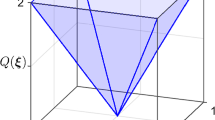Abstract
This paper describes a new direct search method for solving non-standard constrained optimization problems for which standard methodologies do not work properly. Our method (the Rational Iterative Multisection-RIM-algorithm) consists of different stages that can be interpreted as solutions according to different precision requirements. We have performed an application of RIM method to the case of public inputs provision. We prove that the RIM approach and standard methodologies achieve the same results with regular optimization problems while the RIM algorithm takes advantage over others comparable direct-search methods when facing non-standard optimization problems.
Similar content being viewed by others
References
Atkinson A. B., Stern N. H. (1974) Pigou, taxation and public goods. Review of Economic Studies 41: 119–128
Benninga S. (1989) Numerical techniques in finance. MIT Press, London, England
Burmen A., Janez P., Tadej T. (2005) Grid restrained Nelder–Mead algorithm. Computational Optimization and Applications 34: 359–375
Casado L. G., Csendes T., García I. (2000) A new multisection technique in interval methods for global optimization. Computing 65(3): 263–269
Casado L. G., Csendes T., Fernández J., Markót M. Cs. (2006) New interval methods for constrained global optimization. Mathematical Programming 106: 287–318
Chang M. (2000) Rules and levels in the provision of public goods: The role of complementarities between public good and taxed commodities. International Tax and Public Finance 7: 83–91
Colombier C., Pickhardt M. (2005) A note on public input specifications. International Advances in Economic Research 11: 13–18
Coope I. D., Price C. J. (2000) Frame based methods for unconstrained optimization. Journal of Optimization Theory and Applications 107: 261–274
Dorsey R. E., Mayer W. J. (1995) Genetic algorithms for estimation problems with multiple optima, nondifferentiability, and other irregular features. Journal of Business and Economic Statistics 13(1): 53–66
Feehan J. P. (1989) Pareto-efficiency with three varieties of public input. Public Finance/Finances Publiques 44: 237–248
Feehan J. P., Matsumoto M. (2000) Productivity-enhancing public investment and benefit taxation: The case of factor-augmenting public inputs. Canadian Journal of Economics 33(1): 114–121
Feehan J. P., Matsumoto M. (2002) Distortionary taxation and optimal public spending on productive activities. Economic Inquiry 40(1): 60–68
Finkel D. E., Kelley C. T. (2006) Additive scaling and the DIRECT algorithm. Journal of Global Optimization 36: 597–608
Gaube T. (2000) When do distortionary taxes reduce the optimal supply of public goods? Journal of Public Economics 76: 151–180
Gaube T. (2005) Financing public goods with income taxation: Provision rules vs. provision level. International Tax and Public Finance 12: 319–334
Gaube T. (2007) A note on the link between public expenditures and distortionary taxation. Economics Bulletin 8(9): 1–10
Gronberg T., Liu L. (2001) The second-best level of a public good: An approach based on the marginal excess burden. Journal of Public Economics Theory 3(4): 431–451
Jones D., Perttunen C., Stuckman B. (1993) Lipschitzian optimization without the Lipschitz constant. Journal of Optimization Theory and Application 79(1): 157–181
Kelley C. T. (1999) Detection and remediation of stagnation in the Nelder–Mead algorithm using a sufficient decrease condition. SIAM Journal on Optimization 10: 43–55
Kelley, C. T. (2003). Solving nonlinear equations with Newton’s method, no 1 in fundamentals of algorithms. Philadelphia, PA: SIAM.
Kolda T. G., Lewis R. M., Torczon V. (2003) Optimization by direct search: New perspectives on some classical and modern methods. SIAM Review 45(3): 385–482
Lee D., Wiswall M. (2007) A parallel implementation of the simplex function minimization routine. Computational Economics 30: 171–187
Martínez D., Sánchez A. J. (2010a) A note on the optimal level of public inputs. Social Choice and Welfare 34(3): 363–369
Martínez, D., & Sánchez, A. J. (2010b). How sensitive is the provision of public inputs to specifications? WP ECON 10.04, Universidad Pablo de Olavide, Departamento de Economia.
Mathews J.H., Fink K.D. (2004) Numerical methods using Matlab (4th ed.). Prentice-Hall, New Jersey
Matsumoto M. (1998) A note on tax competition and public input provision. Regional Science and Urban Economics 28: 465–473
Mavrotas G. (2009) Effective implementation of the e-constraint method in multi-objective mathematical programming problems. Applied Mathematics and Computation 213: 455–465
Mckinnon K. (1998) Convergence of the Nelder–Mead simplex method to a nonstationary point. SIAM Journal on Optimization 9(1): 148–158
Pestieau P. (1976) Public intermediate goods and distortionary taxation. European Economic Review 7: 351–357
Pigou A.C. (1947) A study in public finance (3rd ed.). Macmillan, London
Samuelson P. A. (1954) The pure theory of public expenditure. Review of Economics and Statistics 36: 387–389
Wilson J. D. (1991a) Optimal public good provision with limited lump-sum taxation. American Economic Review 81(1): 153–166
Wilson J. D. (1991b) Optimal public good provision in the Ramsey tax model. Economics Letters 35: 57–61
Xidonas P., Mavrotas G., Psarras J. (2010) Equity portfolio construction and selection using multiobjective mathematical programming. Journal of Global Optimization 47(2): 185–209
Xidonas, P., Mavrotas, G., & Psarras, J. (2010b). Portfolio construction on the Athens Stock Exchange: A multiobjective optimization approach. Optimization (forthcoming).
Author information
Authors and Affiliations
Corresponding author
Rights and permissions
About this article
Cite this article
Sanchez, A.J., Martinez, D. Optimization in Non-Standard Problems. An Application to the Provision of Public Inputs. Comput Econ 37, 13–38 (2011). https://doi.org/10.1007/s10614-010-9213-3
Accepted:
Published:
Issue Date:
DOI: https://doi.org/10.1007/s10614-010-9213-3




